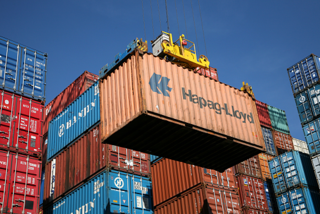
Containers © adpic.de
Global Power Shift
With the fall of the Iron Curtain, the global economy has experienced rapid economic growth. Since 1990, global economic output has quadrupled, global trade flows have increased by a factor of six, and foreign investment stocks have grown by a factor of 13 (UNCTAD). However, the growth of the global economy has not been uniform across the board; it was, above all, the emerging economies of Asia and Latin America that benefited massively from integration into the global economy. Mexico and South Korea have been members of the Organisation for Economic Cooperation and Development (OECD) for many years. China is one of the technology leaders in information and communications technology, in the application of mobile payment and in AI research. Brazil, now the ninth largest economy in the world, is working at a rapid pace to digitise its large agricultural sector.
Asia’s Economic Importance Growing
The share of the EU28 (European Union, 28) in global economic output was 32.8 percent in 1990, compared to only 21.9 percent in 2018. Germany’s share in global production has also fallen since 1990 (7.4 percent) to 4.6 percent. On the other hand, Asian countries, in particular, have been able to increase their share of global GDP in recent decades. Whereas Asia accounted for 23.9 percent of global GDP in 1990, this figure had risen to 37.0 percent by 2018. The clear winner of this shift is China: with a population of around 1 billion people in 1990, the country contributed only 1.7 percent to world production; by 2018 it had already reached 15.9 percent. India generated a gross domestic product (GDP) of 2.7 trillion U.S. dollars in 2018, which represents an increase of 256 percent since 2000.
A similar picture emerges when looking at global trade flows. Germany’s share of world trade has fallen significantly: from twelve percent in 1990 to eight percent in 2018; the situation is similar for the EU28 as a whole (from 44.7 % to 33.3 %). By contrast, China was able to increase its share in world trade by a factor of six (from 1.8 % to 12.8 %). In view of Asia’s massive increase in exports, it is not surprising that the Asian countries have also been able to expand their role as globally active and financially strong investors in recent decades.
Latin America in an Economic Upswing
Brazil is regarded the economic powerhouse of South America. Generating a GDP of 1.87 trillion U.S. dollars in 2018, the country’s economic output has doubled since 2000. The country has a domestic market of 210 million inhabitants. It is Germany’s most important trading partner and investment destination in South America. Mexico now has over 120 million inhabitants and, after Brazil, is one of the most industrialised countries in Latin America. German automakers in particular, including VW, Audi, Daimler and, since 2019, BMW, value the country as a production location. In recent years, Mexico has developed into Latin America’s largest automobile producer (number seven in the world). Bosch, Continental, Webasto and many other German automotive suppliers are deeply rooted in the local value chains of the North and South American continents.
Opportunities and Risks
Germany has benefited considerably from the economic rise of the emerging markets. With a total trade volume of 199.3 billion euros (exports plus imports, 2018), China is Germany’s most important trading partner. In addition, German companies have invested massively in China over the past decades and employ around 767,000 people there (2017). A further success factor for German companies are their Asian suppliers, which is reflected in the increased share of value added from foreign imports in German exports. These now account for one-third of intermediate products purchased from abroad.
However, the growing importance of the emerging markets is also accompanied by major challenges for Germany. German industry depends on fair conditions for international trade. Such a framework was established in the decades following the Second World War. The World Trade Organisation (WTO), World Bank, International Monetary Fund (IMF), G7, G20 and a myriad of regulatory guardrails make rules-based international trade possible.
The increasing economic weight of emerging economies increases their influence on these institutions. For the first time in the history of globalisation, the regulatory framework could be decisively shaped by non-Western states. Unfortunately, the increased economic and political weight of these countries is not yet equally reflected in their willingness and sense of political responsibility to assume corresponding obligations in international organisations and to show a willingness to shape them. It is precisely in this decisive phase that the United States has withdrawn from its role as a heavyweight in the multilateral order and thus weakened the West’s creative power through trade conflicts.
The Western Model has much to Offer
In global systemic competition with state-capitalist countries such as China and Vietnam, Western countries have enormous competitive advantages to offer: for example, the creative power of free-market competition, the stability and integration of democracy, and the attractiveness of constitutions based on the rule of law for investors. The German government and the European Commission must now do everything in their power to strengthen the forces of the social market economy and the multilateral order. Engagement in global governance forums such as the G20, G7, WTO or OECD is just as necessary as ambitious trade diplomacy and the conclusion of free trade and investment agreements.



